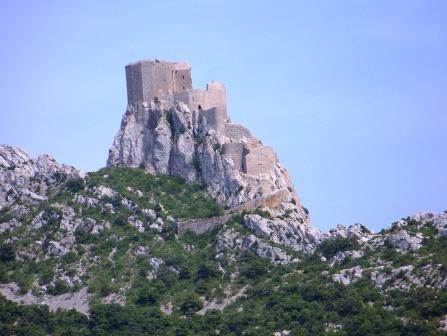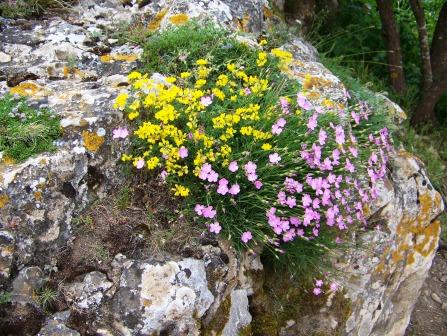Two of the days
we were in Perpignan we headed inland to see the range of appealing sights
that French Catalonia had to offer. These sights included castles dating from
the Middle Ages, including the Château d'Aguilar and the Château
de Peyrpertuse, built to defend this border region. They included medieval
monastery churches, such as Saint-Michel-de-Cuxa and the Prieuré de
Serrabone, built in remote locations to encourage quiet devotion. They also
included picturesque mountain villages, like Villefranche-de-Confluent. And
they included amazing natural wonders, like the Grotte des Canalettes and
the Orgues d'Ille-sur-Têt.


The landscape
of the eastern Pyrenees varies considerably. Closer to the coast it is characterized
by large valleys separated by high hills. Not surprisingly, this region has
been a wine-growing area for many centuries, although the wines produced here--including
red wines called Corbières and Côtes du Rousillon, white wines
called Banyuls and Rivesaltes, and sparkling wine called Blanquette de Limoux--are
not well known outside of France. Farther inland, the Pyrenees rise higher
(the Pic du Canigou, below right, is over 9000 feet), the valleys become narrower
and steeper, and the vineyards give way to forests.


Not too
far from the coast, in an inland valley north of Perpignan, is the Château
d'Aguilar, built in the twelfth century
and used until the seventeenth century, when this region no longer formed
the border between France and Spain.



The castle rises
on a steep-slopped peak that even today is difficult to approach.




Some of the rooms
of the old castle remain as haunting reminders of the past.





The view from
the castle walls over the surrounding countryside is truly impressive.



Even in small things, the beauty
of the mountain setting is striking.




The Prieuré de Serrabone
is another of these splendid medieval churches, built in the eleventh century.


What survives of the cloister
looks out over the river valley below.


The glory of Serrabone, though,
is the cluster of columns inside the church, carved in pink marble in the
twelfth century
and covered with an astounding assortment of sculpted human figures, animals,
vines, and other interlacing designs.








We stopped
for lunch one day in Villefranche-de-Confluent, an appealing mountain village,
completely contained
still within its medieval walls and consisting only of two long streets intersected
here and there with short cross-streets.)
Notice the yellow and red striped Catalan flag in the lower left photo, a
common sight in this area.




The town was founded in the eleventh
century, and its fortifications were repeatedly improved,
since it sits astride one of the few valleys that lead from the mountains
to the coast.

In the seventeenth century it
was refortified under King Louis XIV of France, who worried about a Spanish
invasion.


Not too far away
was the Grotte des Canalettes, a self-guiding cave tour that extends a mile
into the mountainside.
The day that we visited it, we were the only ones there, which made the visit
all the more special.
They have a sound and light show that was mesmerizing--as the lights shine
on different features with music.




The feature below looks like bacon
strips!

Another amazing
nature feature are the Orgues d'Ille-sur-Têt, the result of erosion
over millions of years.
We parked at the entrance and hiked in an around the formations for about
an hour.








Click
here to go to the next page for the weird village of Rennes-le-Château.
Close this page to return to the
main menu and map of southern France.